Physical Address
304 North Cardinal St.
Dorchester Center, MA 02124
Choristoma : An overgrowth of tissues that is mature and found in an area where such tissue is not usually present, such as an osseous or cartilaginous choristoma of the tongue.
Hamartoma : An overgrowth of tissue that is mature and normally found in that area, such as a leiomyomatous hamartoma.
Nevus : An overgrowth of tissue that is normally found in the skin or oral mucosa, such as melanocytic, epidermal, or vascular nevus.
Terminology will likely evolve over the next few years. Lesions previously considered hamartomas or nevi may be found to harbor mutations (such as melanocytic nevi) and be more appropriately classified as neoplasms, although for historical reasons, the nomenclature may be retained.
While the disorders here have been classified into macular lesions, nodules, and cystic lesions, there is overlap between nodular or mass-like lesions and cystic lesions since some mass-like heterotopias such as gastrointestinal heterotopias are often cystic
Developmental macular epithelial conditions fall into three categories: diffuse white lesions, diffuse red lesions, and nevi that may be mucosa-colored or pigmented. Diffuse white lesions are often dyskeratotic and represent oral manifestations of genodermatoses, of which the most well-known is Cannon white sponge nevus that involves mucosal sites only. Patients with dyskeratosis congenita develop reticulate skin pigmentation, nail dystrophy, bone marrow failure over time, and oral dysplastic leukoplakias at a young age. Oral lesions of pachyonychia congenita are rarely biopsied, because the diagnosis is established via skin biopsies. Oral lesions of hereditary mucoepithelial dysplasia, a condition of defective expression of cytoskeleton junctional elements, presents as erythematous plaques.
Lesions are noted in the first two decades of life and persist throughout life. The skin is not involved, although there may be esophageal, upper airway, and genital involvement.
The buccal mucosa (the most commonly affected site) appears diffusely white to gray, thickened, nontender, edematous, and spongy. The tongue, lip mucosa, and floor of the mouth may also be involved ( Fig. 2.1 ).

White sponge nevus is a rare, autosomal dominant condition resulting from a mutation of the helical domain of keratins K4 (chromosome 12q) and K13 (chromosome 17q), leading to keratin instability and abnormal tonofilament aggregation. There may be abnormal degradation of K13 protein and abnormal ubiquitination.
Variable parakeratosis and acanthosis with cytoplasmic vacuolation are partly due to glycogen but mostly from abnormal aggregation of keratin and not spongiosis. There is minimal to no inflammation ( Fig. 2.2 A–C).
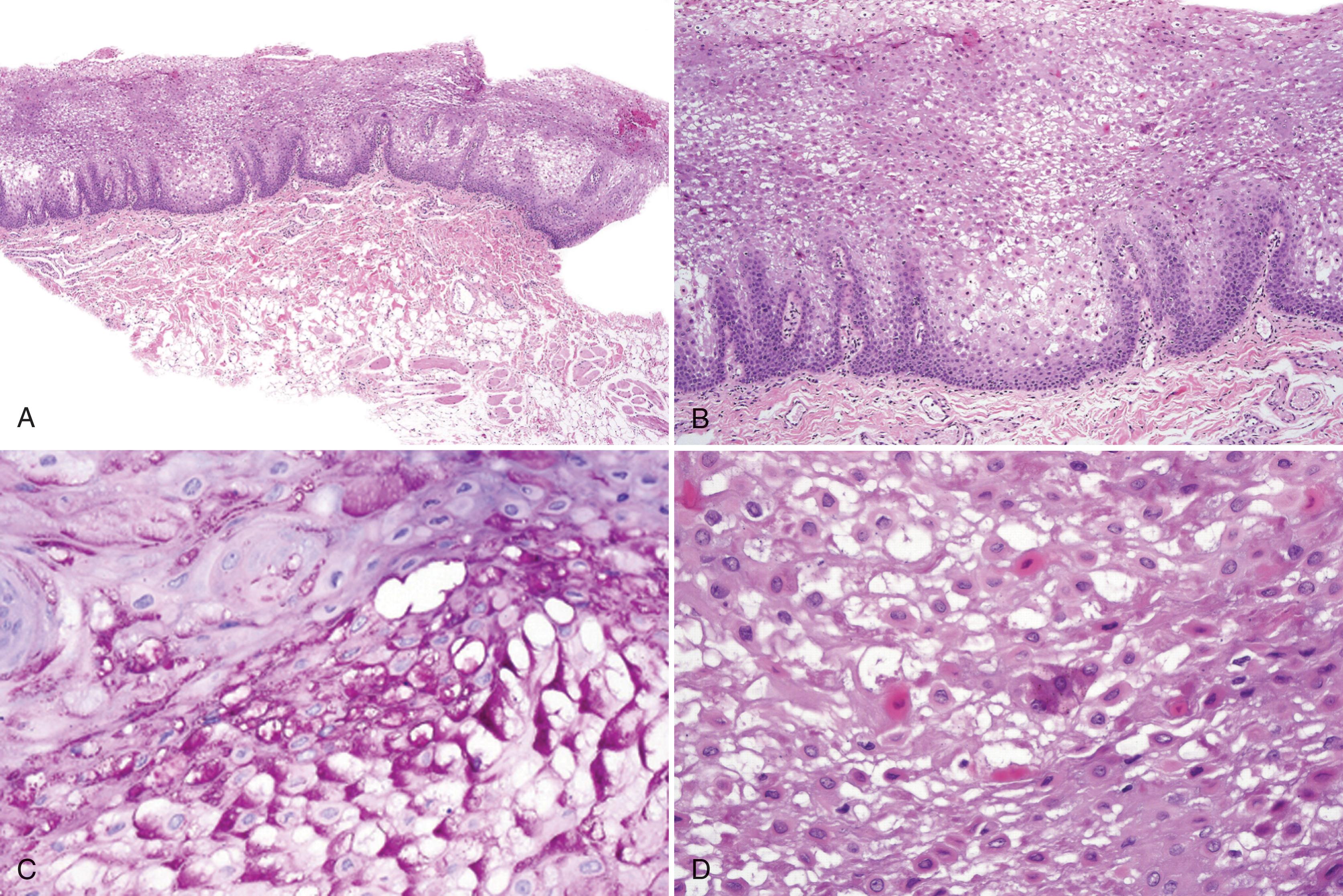
Perinuclear eosinophilic condensations of keratin and dyskeratotic cells are the sine qua non for diagnosis ( Fig. 2.2 D).
High Ki-67 index has been reported.
Chronic frictional/factitial keratosis of the buccal mucosa, a very common condition, exhibits shaggy parakeratosis often with bacterial colonization, acanthosis, and keratinocytic edema but not perinuclear keratin condensations (see Chapter 10 ).
Hereditary benign intraepithelial dyskeratosis exhibits dyskeratosis and “cell-within-a-cell” structures and sometimes perinuclear condensations. Patients have gelatinous conjunctival lesions.
Keratosis follicularis exhibits dyskeratosis as well as acantholysis.
Other genodermatoses such as pachyonychia congenita exhibit similar histology, tends to affect the tongue more than the buccal mucosa, but extensively involves the nails and skin; 55% of cases show oral involvement but diagnosis is generally with a skin biopsy. Depending on the type, mutations occur in one of five keratin genes, KRT6A , KRT6B , KRT6C , KRT16 , and KRT17 resulting in tonofilament misaggregation.
There is no effective treatment. Patients who purportedly respond to antibiotic or chlorhexidine therapy are likely to have some other entity, such as frictional keratoses, which typically wax and wane.
Bezerra KT, Leite TC, Roza A, et al. White sponge nevus: a condition not always clinically suspected. J Cutan Pathol . 2020;47:22-26.
Cai W, Jiang B, Yu F, et al. Current approaches to the diagnosis and treatment of white sponge nevus. Expert Rev Mol Med . 2015;17:e9.
Kurklu E, Ozturk S, Cassidy AJ, et al. Clinical features and molecular genetic analysis in a Turkish family with oral white sponge nevus. Med Oral Patol Oral Cir Bucal . 2018;23:e144-e150.
Samuelov L, Smith FJD, Hansen CD, Sprecher E. Revisiting pachyonychia congenita: a case-cohort study of 815 patients. Br J Dermatol . 2020;182:738-746.
This is diagnosed in the first two decades of life and affects Haliwa-Saponi Native Americans in North Carolina and their descendants (usually on the east coast of the United States), although sporadic cases exist. The skin is not affected.
The oral mucosa exhibits diffuse, thickened, nontender, spongy white plaques similar to white sponge nevus ( Fig. 2.3 A–B).
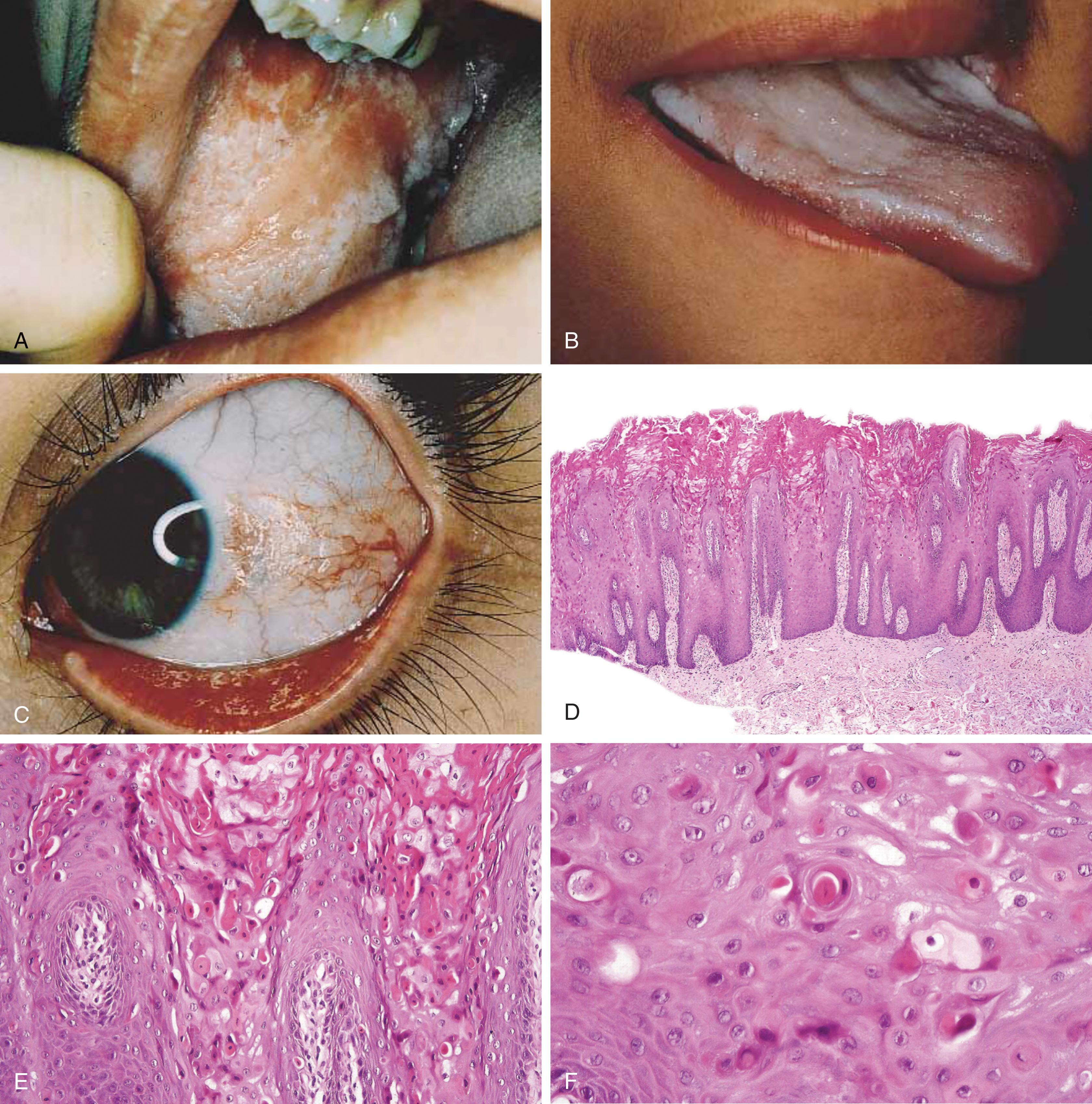
Eye lesions are present as gelatinous plaques on bulbar conjunctiva in a perilimbic location (see Fig. 2.3 C).
Hereditary benign intraepithelial dyskeratosis is an autosomal dominant condition resulting from a duplication (without coding regions) on chromosome 4q35. There is a corneal dyskeratotic condition that does not also affect the oral mucosa but does affect the laryngeal mucosa that exhibits a missense mutation of the NLRP1 on chromosome 17p13.
Parakeratosis, acanthosis, and many dyskeratotic “tobacco” cells (so called because of their brown color seen in Papanicolaou stains) are located in the upper epithelium. Sometimes these dyskeratotic cells are surrounded by epithelial cells, resulting in a cell-within-a-cell appearance (see Fig. 2.3 D–F). Perinuclear condensations may be present.
White sponge nevus shows perinuclear keratin condensations.
Keratosis follicularis and warty dyskeratoma are acantholytic and dyskeratotic.
There is no effective treatment.
Allingham RR, Seo B, Rampersaud E, et al. Duplication in chromosome 4q35 is associated with hereditary benign intraepithelial dyskeratosis. Am J Hum Genet . 2001;68:491-494.
Baroni A, Palla M, Aiello FS, et al. Hereditary benign intraepithelial dyskeratosis: case report. Int J Dermatol . 2009;48:627-629.
Bui T, Young JW, Frausto RF, Markello TC, Glasgow BJ, Aldave AJ. Hereditary benign intraepithelial dyskeratosis: report of a case and re-examination of the evidence for locus heterogeneity. Ophthalmic Genet . 2016;37:76-80.
Cummings TJ, Dodd LG, Eedes CR, Klintworth GK. Hereditary benign intraepithelial dyskeratosis: an evaluation of diagnostic cytology. Arch Pathol Lab Med . 2008;132:1325-1328.
Haisley-Royster CA, Allingham RR, Klintworth GK, Prose NS. Hereditary benign intraepithelial dyskeratosis: report of two cases with prominent oral lesions. J Am Acad Dermatol . 2001;45:634-636.
Jham BC, Mesquita RA, Aguiar MC, Carmo MA. Hereditary benign intraepithelial dyskeratosis: a new case? J Oral Pathol Med . 2007;36: 55-57.
Soler VJ, Tran-Viet KN, Galiacy SD, et al. Whole exome sequencing identifies a mutation for a novel form of corneal intraepithelial dyskeratosis. J Med Genet . 2013;50:246-254.
Darier disease in the mouth does not occur in the absence of skin lesions. A localized papule or nodule with similar histopathology is known as warty dyskeratoma or focal acantholytic dyskeratosis and is discussed in Chapter 3 .
Onset is in first and second decades of life with lesions on the palatal mucosa, gingiva, or tongue, all keratinized sites. White, painless, keratotic papules (seen in mild disease) or plaques, and cobblestoning of the oral mucosa (seen in more severe disease) are noted in 10% to 50% of patients with skin disease ( Fig. 2.4 ).
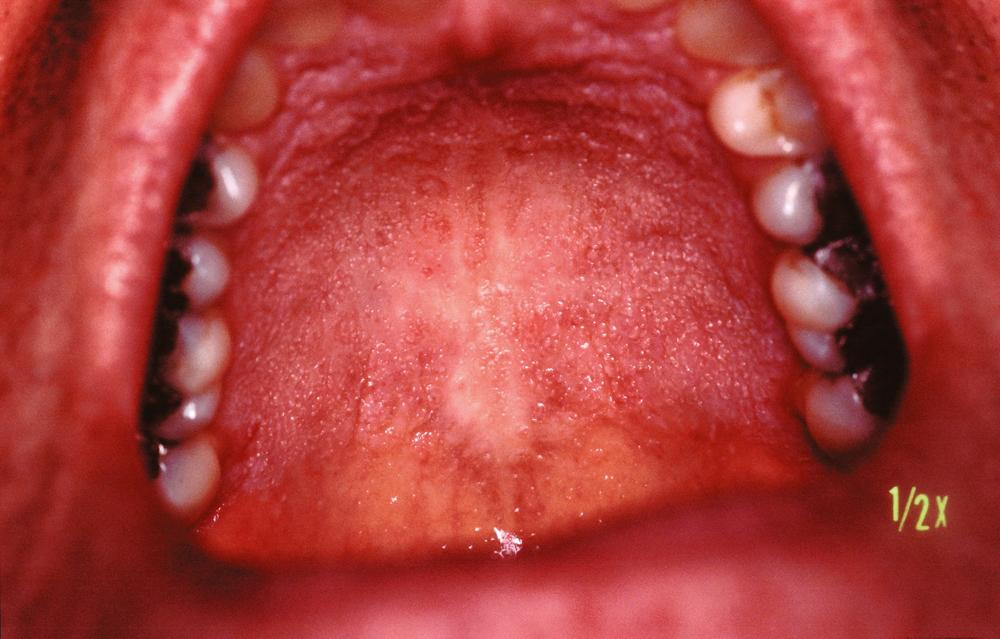
Up to one-third of cases exhibit parotid or submandibular swelling that is likely due to duct strictures and obstruction.
Darier disease is an autosomal dominant disorder associated with a mutation of ATP2A2 on chromosome 12, which encodes sarcoendoplasmic Ca 2+ -ATPase isoform 2 (SERCA2). This protein is involved in the transport of calcium from the cytoplasm into the endoplasmic reticulum as well as posttranslational protein processing required for proper functioning of desmosomes and keratin. The mutation results in dyscohesion.
There is parakeratosis and acanthosis with suprabasal clefts, and dyskeratosis presenting as rounded keratinocytes with abundant brightly eosinophilic cytoplasm (corps ronds) as well as spindled keratinocytes with pyknotic and spindled nuclei (grains). This is similar to the findings of warty dyskeratoma (see Chapter 3 ).
Lesions of pemphigus also exhibit suprabasal clefts and acantholysis but would exhibit intercellular IgG in direct immunofluorescence studies.
Darier disease is managed with topical retinoids, topical 5-fluorouracil, calcineurin inhibitors, diclofenac sodium, laser therapy, and photodynamic therapy.
Adams AM, Macleod RI, Munro CS. Symptomatic and asymptomatic salivary duct abnormalities in Darier’s disease: a sialographic study. Dentomaxillofac Radiol . 1994;23:25-28.
Burge SM, Wilkinson JD. Darier-White disease: a review of the clinical features in 163 patients. J Am Acad Dermatol . 1992;27:40-50.
Frezzini C, Cedro M, Leao JC, Porter S. Darier disease affecting the gingival and oral mucosal surfaces. Oral Surg Oral Med Oral Pathol Oral Radiol Endod . 2006;102:e29-e33.
Haber RN, Dib NG. Management of Darier disease: a review of the literature and update. Indian J Dermatol Venereol Leprol . 2021;87:14-21.
Macleod RI, Munro CS. The incidence and distribution of oral lesions in patients with Darier’s disease. Br Dent J . 1991;171:133-136.
Savignac M, Simon M, Edir A, et al. SERCA2 dysfunction in Darier disease causes endoplasmic reticulum stress and impaired cell-to-cell adhesion strength: rescue by Miglustat. J Invest Dermatol . 2014;134:1961-1970.
Takagi A, Kamijo M, Ikeda S. Darier disease. J Dermatol . 2016;43:275-279.
Weathers DR, Driscoll RM. Darier’s disease of the oral mucosa. Report of five cases. Oral Surg Oral Med Oral Pathol . 1974;37:711-721.
Usually diagnosed in childhood, this disorder is characterized by perineal and oral erythema, nonscarring alopecia, keratosis follicularis, and recurrent keratitis. This condition may be related to the autosomal dominant form of ichthyosis follicularis atrichia and photophobia syndrome where patients exhibit similar skin findings and angular cheilitis but not the gingival and palatal erythema.
This presents within the first two decades of life as bright red plaques of the gingiva and hard palatal mucosa with angular cheilitis, and fissured tongue. The dentition is normal ( Fig. 2.5 A).
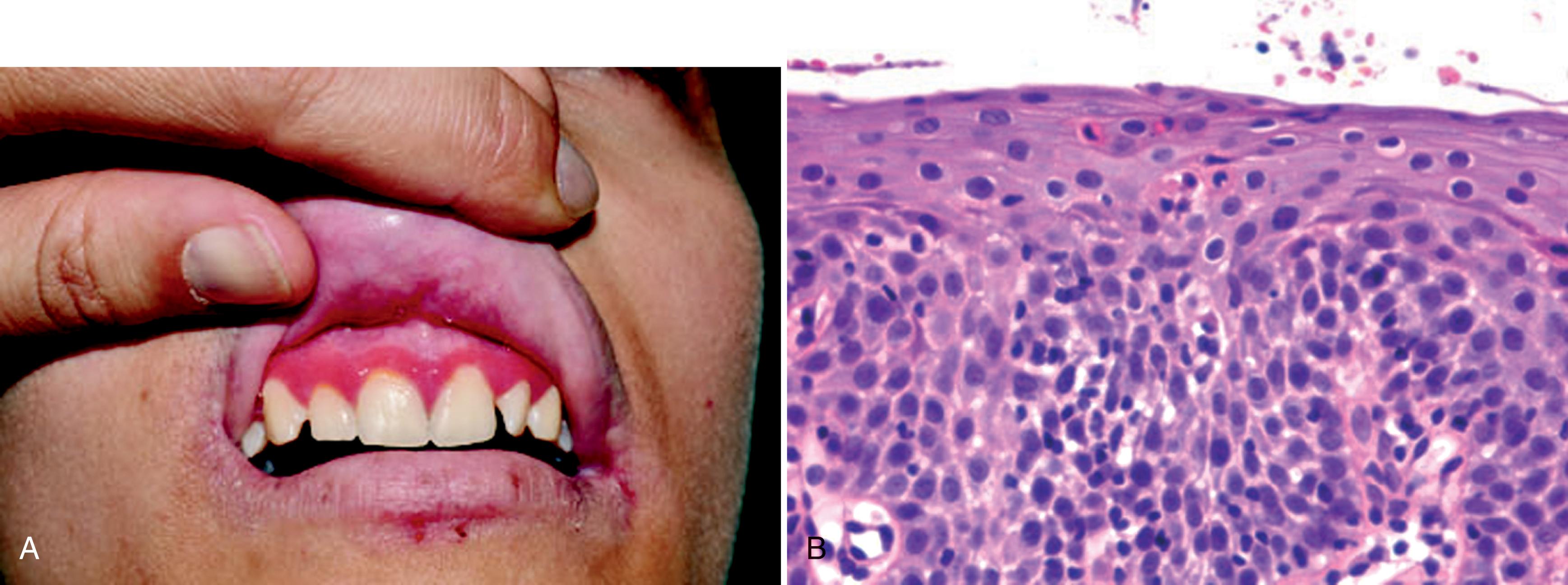
The skin exhibits hypotrichosis, hyperkeratosis, perineal psoriasiform intertrigo, follicular hyperkeratosis cataract formation, and recurrent keratitis.
Hereditary mucoepithelial dysplasia is an autosomal condition (although there are also sporadic cases) resulting from a mutation in SREBF1 that codes a transcription factor that controls cholesterol and fatty acid synthesis. This may in turn result in an abnormality in the permeability of the epithelial barrier, probably through the disruption of normal cholesterol and free fatty acids synthesis, which is essential for the exchange of water and electrolytes in the epithelium as well as for epithelial differentiation. This same gene is responsible for the autosomal dominant form of ichthyosis follicularis atrichia and photophobia syndrome where patients exhibit angular cheilitis but not the gingival and palatal erythema indicating that these two conditions are related.
There is variable papillomatosis, dyscohesion, dyskeratosis, vacuolations within keratinocytes, and lack of intercellular bridges. Dyskeratotic cells are sometimes seen surrounded by keratinocytes, giving a cell-within-a-cell appearance ( Fig. 2.5 B).
Ultrastructural examination reveals a reduced number of desmosomes and internalized gap junctions.
There is no effective treatment.
Boralevi F, Haftek M, Vabres P, et al. Hereditary mucoepithelial dysplasia: clinical, ultrastructural and genetic study of eight patients and literature review. Br J Dermatol . 2005;153:310-318.
Hernández-Martín A, Colmenero I, Torrelo A. Hereditary mucoepithelial dysplasia: report of two sporadic cases. Pediatr Dermatol . 2012;29:311-315.
Irurzun I, Natale MI, Agostinelli ML, et al. Ichthyosis follicularis, atrichia and photophobia (IFAP) and hereditary mucoepithelial dysplasia: two syndromes that share a common clinical spectrum. Pediatr Dermatol . 2021;38:568-574.
Morice-Picard F, Michaud V, Lasseaux E, et al. Hereditary mucoepithelial dysplasia results from heterozygous variants at p.Arg557 mutational hotspot in SREBF1, encoding a transcription factor involved in cholesterol homeostasis. J Invest Dermatol . 2020;140:1289-1292.e2.
Cutaneous epidermal nevi (nonsyndromic forms) are divided into organoid types where adnexal structures such as sebaceous glands are present, or nonorganoid types that are primarily epidermal and the latter are also known as keratinocytic epidermal nevi.
Generally noted in infancy or childhood, linear pigmented and verrucous papules and plaques occur unilaterally on the skin following the lines of Blaschko.
Oral involvement is uncommon but when present, the corresponding oral papillary plaques may be extensive and multifocal. These are mucosa-colored in a unilateral distribution or sometimes present at the midline. The lips, tongue, and palatal mucosa are the most common sites. Infrequently, there may be missing teeth or enamel hypoplasia. Oral lesions rarely occur without skin lesions ( Fig. 2.6 A).
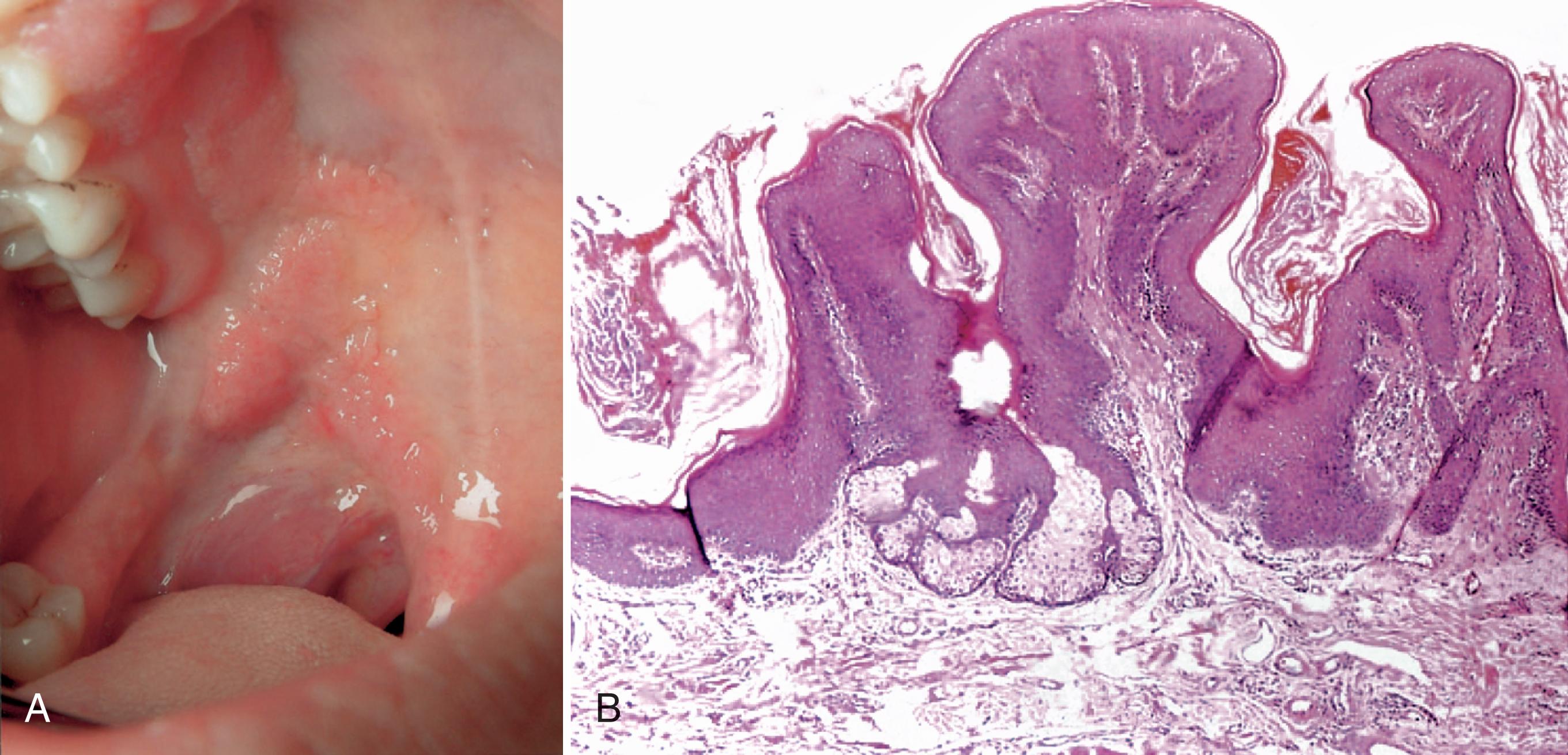
Rare intraoral epidermal nevi may occur in the absence of corresponding skin lesions and these are sometimes referred to as epidermal choristomas (see later).
Linear epidermal nevi although historically considered hamartomatous malformations exhibit RAS , FGFR2 , and PIK3CA mutations in 8% to 40% of cases.
Hyperkeratosis and papillary acanthosis are present, sometimes with sebaceous glands (see Fig. 2.6 B).
Condylomas may appear similar histologically but are positive for koilocytes, positive for human papillomavirus-6 or human papillomavirus-11, and are generally discrete and circumscribed. They are unassociated with linear skin lesions.
Squamous papilloma and verruca vulgaris are almost always solitary lesions with verruca vulgaris exhibiting coarse keratohyaline granules.
Excision or laser ablation may be appropriate for small oral lesions but may not eradicate larger lesions.
Gomes RT, Vargas PA, Tomimori J, Lopes MA, Santos-Silva AR. Linear verrucous epidermal nevus with oral manifestations: report of two cases. Dermatol Online J . 2020;26:13030/qt46n048wn.
Haberland-Carrodeguas C, Allen CM, Lovas JG, et al. Review of linear epidermal nevus with oral mucosal involvement—series of five new cases. Oral Dis . 2008;14:131-137.
Hafner C, Toll A, Gantner S, et al. Keratinocytic epidermal nevi are associated with mosaic RAS mutations. J Med Genet . 2012;49: 249-253.
Maly C, Olmo H, Stoes S, et al. Linear epidermal nevus: a case report with oral and facial manifestations. J Oral Maxillofac Surg . 2016;74:2000-2006.
Ozçelik D, Parlak AH, Oztürk A, et al. Unilateral linear verrucous epidermal nevus of the face and the oral mucosa. Plast Reconstr Surg . 2005;115:17e-19e.
Tesi D, Ficarra G. Oral linear epidermal nevus: a review of the literature and report of two new cases. Head Neck Pathol . 2010;4:139-143.
This usually occurs within the first 3 months of life, presenting as brown plaques or macules, usually on the tongue, although some cases occur in adults. It differs from oral linear epidermal nevus in that it is unassociated with a cutaneous epidermal nevus.
Oral epidermal nevus represents a developmental overgrowth of tissues, such as mature pilosebaceous units and other skin adnexa, that one would not normally see in the oral cavity.
Hyperkeratosis, hypergranulosis, melanosis of basal cells with or without melanocytic hyperplasia, pilosebaceous, and other adnexal structures are noted within the lamina propria ( Fig. 2.7 ).
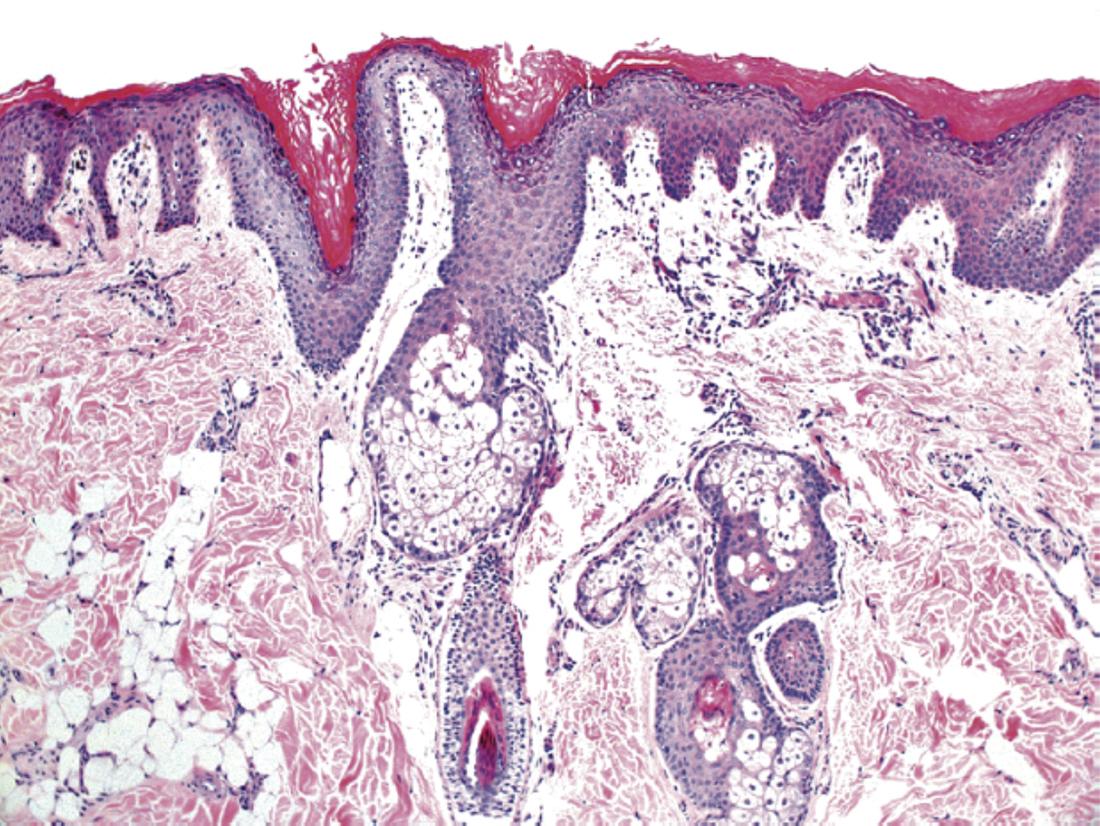
Sebaceous hyperplasia (hyperplastic Fordyce granules) and sebaceous adenoma do not exhibit significant numbers of hair follicles.
Congenital melanotic macules do not usually exhibit pilosebaceous units.
Dermoid tumor (hairy polyp) is clinically a polypoid mass covered by epidermis and contains many pilosebaceous units.
Excision is curative.
Azorin D, Enriquez de Salamanca J, de Prada I, et al. Congenital melanotic macules and sebaceous choristoma arising on the tongue of a newborn: epidermal choristoma? J Cutan Pathol . 2005;32:251-253.
Chi AC, Mapes IL, Javed T, Neville BW. Epidermal choristoma of the oral cavity: report of 2 cases of an extremely rare entity. J Oral Maxillofac Surg . 2010;68:451-455.
Curto-Barredo L, Vicente A, Rovira C, et al. Epidermal choristoma of the tongue mimicking a congenital melanotic macule. Pediatr Dermatol . 2015;32:536-538.
Yoshioka I, Marutsuka K, Igawa K, et al. Epidermal choristoma arising on the midline gingiva as a congenital epulis: a case report. J Craniomaxillofac Surg . 2012;40:812-814.
This is an uncommon condition that is part of a heterogenous group of palmoplantar keratodermal conditions that includes Papillon-Lefevre syndrome that is associated with severe localized periodontitis or Howel-Evans syndrome associated with esophageal carcinoma. Focal palmoplantar and gingival keratosis syndrome affects the keratinized tissues of the oral cavity namely the palatal mucosa, gingiva, and dorsum of tongue. Patients develop pressure-related painful hyperkeratoses of the palms and soles, sometimes referred to as tylosis.
Onset is usually in childhood and puberty, worsening as the patient grows older. The gingival lesions are characterized by diffuse, painless, smooth white plaques on the attached gingiva and patients often also exhibit diffuse whiteness of the hard palatal mucosa and dorsum of tongue.
The palmar and plantar surfaces exhibit thick yellow keratotic plaques, and patients may also exhibit peri- and subungual keratoses, hyperhidrosis, and follicular hyperkeratosis.
This has an autosomal dominant inheritance pattern and is not caused by a mutation in one of the known keratin genes.
There is hyperkeratosis and acanthosis with dyskeratotic cells with eosinophilic keratin condensations reported as “paranuclear bodies”. There is minimal inflammation in the lamina propria. There may be focal epidermolytic hyperkeratosis.
The findings are not specific and may resemble those of other dyskeratotic genodermatoses such as pachyonychia congenita. It is the clinical manifestations that help to distinguish this from oral manifestation of other genodermatoses.
There is no effective treatment for this condition.
Gerber-Mora R, Jajam-Maturana M, Fernandez-Moraga A, Martinez-Flores R. Focal palmoplantar and gingival keratosis—a rare genodermatoses: case report. J Clin Exp Dent . 2020;12:e1096-e1099.
Kolde G, Hennies HC, Bethke G, Reichart PA. Focal palmoplantar and gingival keratosis: a distinct palmoplantar ectodermal dysplasia with epidermolytic alterations but lack of mutations in known keratins. J Am Acad Dermatol . 2005;52:403-409.
Seehra J, Thakker N, Duxbury AJ, Sloan P, Ariyaratnam S. Focal palmoplantar and gingival hyperkeratosis: a case report. Dent Update . 2007;34:290-292, 294.
Young WG, Newcomb GM, Daley TJ. Focal palmoplantar and gingival hyperkeratosis syndrome: report of a family, with cytologic, ultrastructural, and histochemical findings. Oral Surg Oral Med Oral Pathol . 1982;53:473-482.
Become a Clinical Tree membership for Full access and enjoy Unlimited articles
If you are a member. Log in here